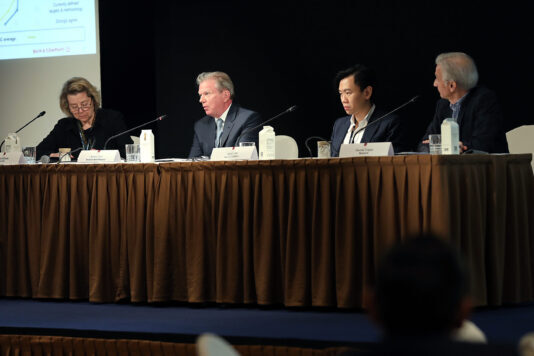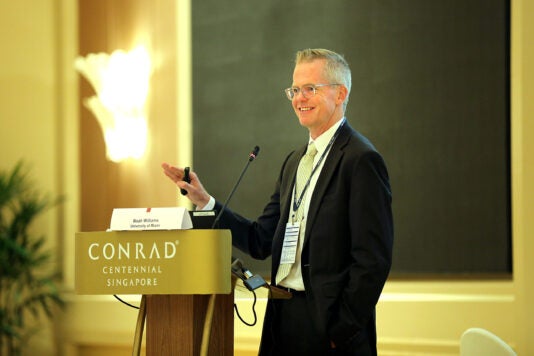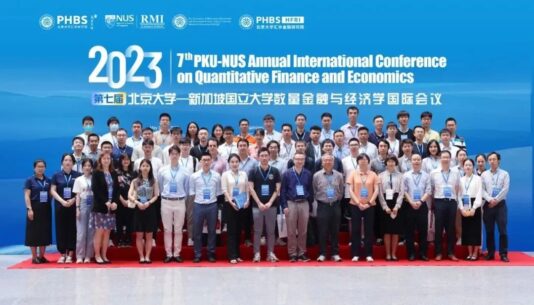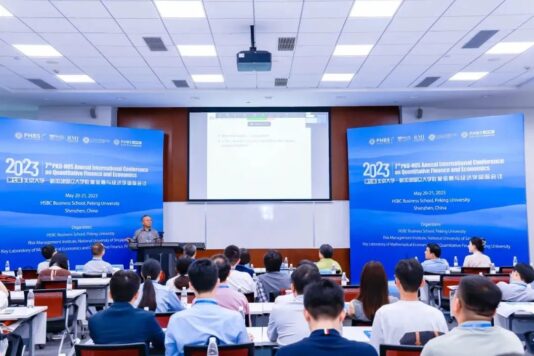|
| |
Sixteenth Annual Risk Management Conference Unveils Novel Insights in Evolving Risk Landscape
By Zhang Jiawei, MFE Alumni
|
|
| |
The Sixteenth Annual Risk Management Conference, a premier event orchestrated by the NUS Risk Management Institute (RMI), unfolded at Conrad Centennial Singapore, on 31 July 2023. This exclusive congregation of distinguished academics, industry luminaries, and thought leaders from the spheres of risk management and finance convened to unravel the latest paradigms and pioneering methodologies in risk evaluation and strategic management. This pivotal conference spanned a comprehensive day-long itinerary, characterized by a diverse array of illuminating sessions, keynote addresses, and illuminating panel discussions. The conference was inaugurated with a gracious welcome and enlightening introductory remarks by the esteemed Prof. Yi-Chun Chen, the Director of the illustrious NUS Risk Management Institute. Prof. Chen extended his heartfelt appreciation to the International Association of Credit Portfolio Managers (IACPM) for their invaluable collaboration in crafting this intellectual fiesta. He provided a comprehensive overview of the conference’s progression over the years, underscoring its pivotal role in advancing the frontiers of risk management knowledge. He also took the opportunity to introduce the audience to the RMI’s multifaceted endeavours, including the avant-garde Master of Science (Financial Engineering) Program, and shed light on the institute’s ongoing research ventures. A monumental highlight of this congregation was the spellbinding keynote address delivered by Nobel Laureate Prof. Lars Peter Hansen, David Rockefeller Distinguished Service Professor in Economics, Statistics, Booth School of Business, University of Chicago. Prof. Hansen is a leading expert in economic dynamics who works at the forefront of economic thinking and modeling, drawing approaches from macroeconomics, finance, and statistics. The mantle of introducing Prof. Hansen was conferred upon Prof. Neng Wang, an erudite scholar holding the Chong Khoon Lin Professor of Real Estate and Finance position at Columbia Business School. Prof. Wang paid homage to Prof. Hansen’s profound influence on his academic journey, hailing him as a teacher, mentor, and friend. The introductory discourse underscored Prof. Hansen’s seminal contributions to the economic landscape, notably the epochal development of the Generalized Method of Moments (GMM) technique.
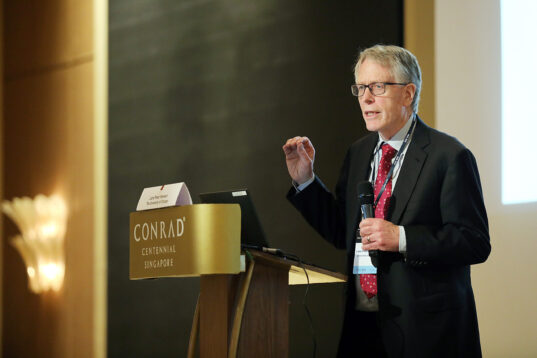
The focal point of Prof. Hansen’s keynote address bore the theme “How Should Climate Change Uncertainty Impact Social Valuation and Policy?” This captivating exposition delved into the intricate interplay between the enigma of climate change uncertainty, its implications on societal valuation, and the strategic underpinnings of policy formulation. Prof. Hansen masterfully navigated through the realms of decision theory, dissecting concepts of risk, ambiguity, and misspecification. He eloquently argued for the adoption of simplified models as robust tools to tackle these multifaceted challenges head-on. The discourse further probed the terrain of asset pricing valuation, accentuating the indispensability of recalibrating valuation mechanisms to accommodate uncertainty. Prof. Hansen spotlighted two pivotal facets within this context: the assets burdened with the societal cost of carbon and those enriched by the societal value of research and development. He accentuated the imperative of weaving the fabric of decision theory into the very essence of valuation, necessitating nuanced adjustments for uncertain cash flows, ambiguous probabilities, and uncertain discount rates.
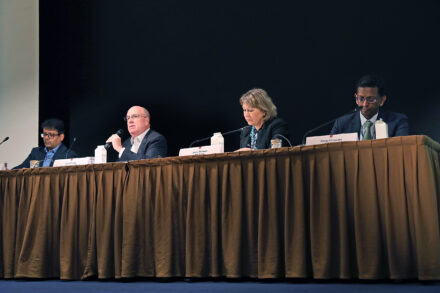
The conference’s continuum embraced two engrossing panel discussions, pulsating with insights on pertinent topics. The first panel, bearing the intriguing epithet “Risk Landscape – The Year of Inflection,” convened luminaries to delve into the crucible of escalating geopolitical perturbations, tectonic shifts in monetary policy contours, and the burgeoning prominence of operational risks, typified by the specter of cyber threats. The panelists, including Mr. David Dredge, Chief Investment Officer of Convex Strategies Pte Ltd, Mr. Philip Fernandez, Corporate Treasurer of DBS Group, and Ms. Jayne Plunkett, Group Chief Risk Officer of AIA Group, collectively illumined the strategies undertaken by risk practitioners in the global financial ecosystem to grapple with this year of epochal inflection. The session found its astute helmsman in Mr. Lutfey Siddiqi, an erudite Adjunct Professor at NUS RMI.
|
|
|
| |
The second panel, a collaborative endeavour with the esteemed International Association of Credit Portfolio Managers (IACPM), unfurled under the aegis of “ESG and Climate – Challenges and Strategic Opportunities for Asia.” This comprehensive discourse encompassed a gamut of pivotal aspects, traversing the spectrum from assimilating climate risk variables into corporate mechanisms to scrutinizing the operational contours of the ESG (Environmental, Social, and Governance) model, while espousing informed business and risk decisions. The dais was graced by the captivating presence of Mr. Rafael Lam, Partner at Bain & Company, who delivered the inaugural remarks and later engaged as a panelist. The panel conversation probed the practical dimensions of integrating ESG frameworks and strategic realignment in the Asian context, against the backdrop of the multi-crisis environment. The eminent voices of Dr. Davide Crippa, Chief Risk Officer of Maybank, and Mr. Seamus Toal, Chief Risk Officer, Asia and Independent Director of Deutsche Bank Malaysia, resounded within this spirited deliberation. The proceedings were adroitly orchestrated by the insightful moderation of Ms. Marcia Banks, Deputy Director of IACPM. As the day progressed, the conference’s contours expanded to encompass plenary talks and a multitrack assortment of presentations. Prof. Noah Williams, an eminent Centennial Endowed Chair Professor of Economics at the Miami Herbert Business School, unfurled his discourse on the topic of “Risk-Taking Incentives and Remedies.” Prof. Williams extended static model to dynamic models in contracts to reveal the role of moral hazard in risk management. He then used a simple geometric case and a threshold level variable risk management case to get the conclusion of revealing the hidden risk. Asst Prof. Chang Liu from the Department of Economics at NUS orchestrated this plenary session with consummate finesse. |
|
| |
The unfolding of the conference’s array of tracks ushered in a captivating immersion into myriad subjects. Track A promised a diverse and intriguing lineup. Kicking off with a Contributed Session co-hosted and co-chaired by A/P Ying Chen and Asst Prof. Ming Li from NUS, the stage is set for thought-provoking discussions. A/P Agostino Capponi from Columbia University delivered a Semi-Plenary Talk titled “Disintermediation of Financial Services: Promises, Risks, and Technological Solutions,” shedding light on the evolving landscape of financial services. This track also included presentations on Quantum Finance: Pricing of Classical & Quantum Assets by Patrick Rebentrost, Crypto Asset Analysis: Decentralization and Fraud Detection by Feida Zhu, Explainable Patent Value Prediction Model Using Machine Learning by Wei Li, and Operational Risk Management of Political Risk: Evidence from Customer Concentration by Jingmeng Zhang, all from esteemed institutions. Meanwhile, Track B, co-hosted and co-chaired by A/P Chao Zhou and Asst Prof. Marko Hans Weber, offers a Contributed Session and a Semi-Plenary Talk by Prof. Min Dai from The Hong Kong Polytechnic University, who delved into “Dynamic Trading with Realization Utility.” The track further explores topics including A Probabilistic Solution to High-Dimensional Continuous-Time Macro and Finance Models by Ji Huang from The Chinese University of Hong Kong, Nonlinear Dependence and Households’ Portfolio Decisions Over the Life Cycle by Wei Jiang from Hong Kong University of Science & Technology, Stock Market Simulation by Micro-Macro GAN by Takanori Adachi from Tokyo Metropolitan University, and A Jump-Diffusion Model for Climate Risk Assessment by Max Wong from Singapore Exchange and Yannis Yuan from NUS. |
|
| |
In Track C, hosted and chaired by Asst Prof. Chang Liu from NUS, there was a Contributed Session followed by a thought-provoking Semi-Plenary Talk delivered by Prof. Neil D. Pearson from the University of Illinois at Urbana-Champaign, centered on “A Simple Role for Complex Options.” The sessions in this track covered a wide range of topics, including inefficient investment cycles, financing R&D, corporate debt, and the impact of macroeconomic uncertainty on daily option expirations. To be specific, the presentations are Inefficient Investment Cycles by Zehao Li from The Chinese University of Hong Kong, Shenzhen, Financing R&D by Asst Prof. Chang Liu from NUS, Corporate Debt, Boom-Bust Cycles, and Financial Crises by Asst Prof Karsten Muller from NUS, and The Price of Macroeconomic Uncertainty: Evidence from Daily Option Expirations by Mehrdad Samadi from Federal Reserve Board. Lastly, Track D, chaired by Dr. Zhengqing Gui from NUS brought together experts in the field. A/P Ming Yang from the University College London presented a Semi-Plenary Talk on “Payments, Reserves, and Financial Fragility.” This track also featured discussions on bank risk governance, rebalanced portfolio optimization, time-varying factor selection, and an examination of common measures of stock market volatility risks: Bank Risk Governance by Dietmar Leisen from University of Mainz, Rebalanced Portfolio Optimization by Michael Rey from Octonion Group, Time-Varying Factor Selection: A Sparse Fused GMM Approach by Guanhao Feng from City University of Hong Kong, and Do Common Measures of Stock Market Volatility Risks Have the Same Price by Guanglian Hu from University of Sydney. These presentations offered valuable insights into the world of risk management and finance, making the conference an enriching experience for all attendees. The curtains descended on the Sixteenth Annual Risk Management Conference, leaving an indelible mark of intellectual profundity. The event was imbued with a vibrant aura of collaborative synergy, a testament to the confluence of academic sagacity and industry acumen. In an epoch characterized by unprecedented uncertainty, the conference resonated as a fulcrum for the exchange of transformative insights and innovative strategies in the realm of risk management. As a noteworthy culmination, it is worth mentioning that the NUS Risk Management Institute holds this annual event not only to foster collaboration between academia and industry but also to lead the role of risk management on a global scale. The continued efforts and exceptional outcomes ensure that this insightful and innovative conference will continue to play a guiding role in the field of risk management, providing wise guidance for our collective future. |
|
|
| |
RMI Co-Hosts the Seventh Installment of the PKU-NUS Annual International Conference on Quantitative Finance and Economics
|
|
| |
On 20 & 21 May 2023, the Seventh PKU-NUS International Conference on Quantitative Finance and Economics was held at Peking University HSBC Business School. The conference was jointly organized by Peking University HSBC Business School, National University of Singapore’s Risk Management Institute, and Peking University Key Laboratory of Mathematical Economics and Quantitative Finance of the Ministry of Education. Nearly 200 scholars attended the meeting onsite or online to discuss the latest academic research results in quantitative finance and economics.
At the opening ceremony on 20 May, representatives of the three co-organizing institutes said a few words to welcome the audience. The opening ceremony was hosted by Associate Professor Peng Xianhua, Peking University HSBC Business School. The three opening talks were by: - Professor Wang Pengfei, Vice Dean of Peking University Shenzhen Graduate School and Dean of HSBC Business School,
- Professor Chen Kan, Deputy Director of the Institute of Risk Management of the National University of Singapore, and
- Peking University’s Director Professor Wu Lan.
|
|
|
| |
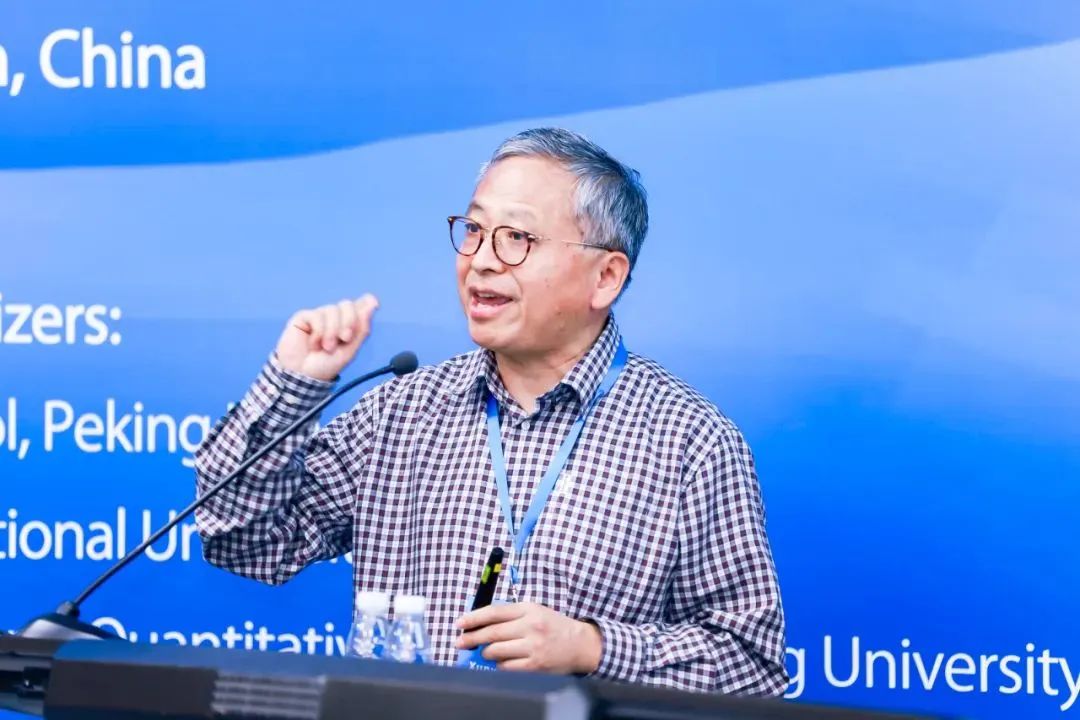
The conference hosted three keynote speakers. The first was Professor Zhou Xunyu, Chair Professor of Financial Engineering in the Department of Industrial Engineering and Operations Research at Columbia University and Director of the FDT Center for Intelligent Asset Management. During his keynote speech, Prof. Zhou introduced his research results of "Reinforcement Learning in Continuous Time and Its Financial Applications". He pointed out that reinforcement learning, through randomized exploration, can balance exploration and the utilization of learned knowledge without knowing the environment model, and can excellently solve stochastic control problems. However, existing reinforcement learning methods mainly focus on discrete-time Markov decision-making problems, which are difficult to solve problems that require high-frequency interaction with the environment, and lack a theory and unified framework. To this end, Prof. Zhou proposed a continuous-time reinforcement learning framework through a series of papers: including the introduction of a random strategy that embodies exploration through the conditional probability distribution of actions under the continuous-time model, and the solution of continuous-time stochastic control problems under the random strategy. He applied the method to the mean-variance portfolio selection problem and found that its performance on the S&P 500 portfolio and the CSI 300 portfolio outperformed the market and other discrete-time reinforcement learning methods. After the keynote speech, the participants discussed topics such as exploration rate selection in reinforcement learning.
|
|
|
|
|
| |
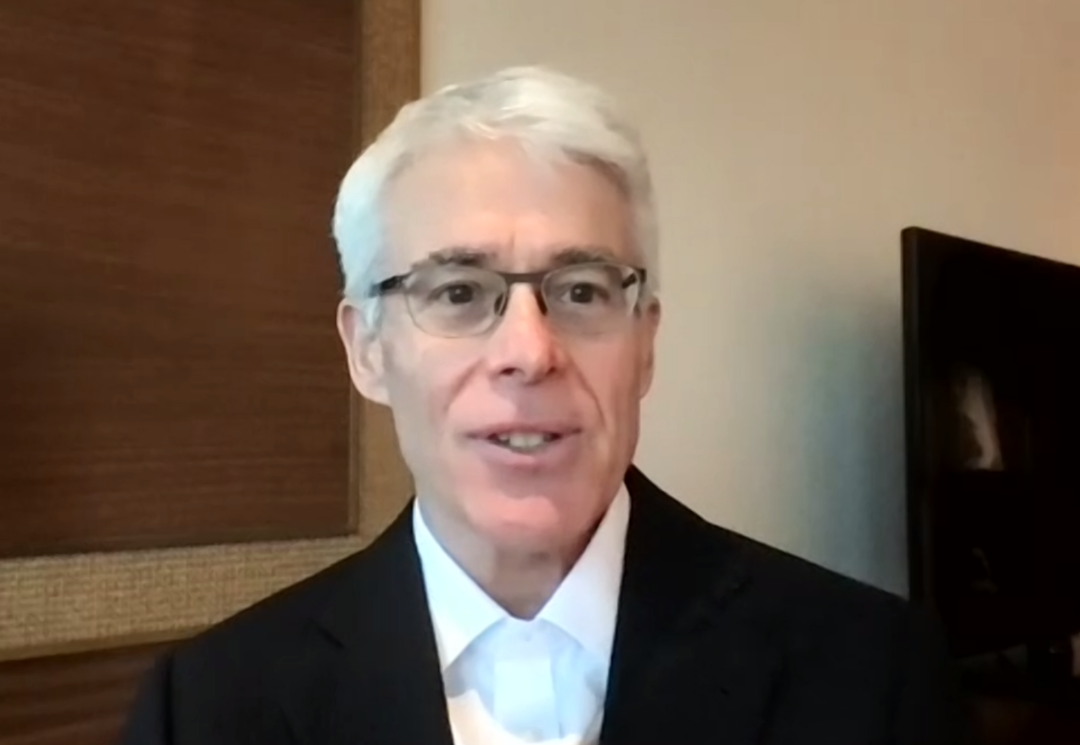
The second keynote talk was by Professor Darrell Duffie, Adams Distinguished Professor of Management and Professor of Finance at the Stanford Graduate School of Business, and Senior Fellow at the Institute for Economic Policy Research at Stanford University. The title of Professor Duffie's speech was "Dealer Intermediation Capacity and US Treasury Market Functionality". Professor Duffie conducted data analysis on the U.S. Treasury bond market and found that during the COVID-19 pandemic, the number of U.S. Treasury bonds sold by foreign investors and dealer bid-ask spreads surged, and the liquidity of the U.S. Treasury bond market and the market depth among dealers plummeted. He pointed out that the U.S. Treasury bond trading market consists of two parts, namely the inter-dealer market and the market between investors and dealers. The resilience of the U.S. Treasury bond market is limited by the intermediary capabilities of dealers. Under normal circumstances, the illiquidity of U.S. Treasury bonds increases linearly with the increase in the implied volatility of interest rate swap options; however, in the extreme case of the COVID-19 pandemic, this linear relationship does not hold because the balance sheets of dealers during the outbreak Table capacity has been exhausted and therefore cannot continue to provide liquidity to investors. Professor Duffie gave policy suggestions on this issue. He suggested that the central bank monitor the balance sheet capacity of dealers, proposed an improved treasury bond auction mechanism, and advised the central bank to distinguish between market function purchases and quantitative easing. After the speech, everyone discussed topics such as the auction mechanism of the U.S. Treasury bond market, how to distinguish market function purchases from quantitative easing, and the Chinese bond market.
|
|
|
|
|
| |

The last keynote talk was by Professor Rama Cont, Chair Professor of Mathematics and Head of the Mathematics and Computational Finance Group at the Institute of Mathematics, University of Oxford. In a presentation titled "Excursion Risk: A New Approach to the Analysis of Dynamic Trading Strategies," Professor Cont discussed trading signals, which are market prices of a portfolio relative to the ones based on the deviation of the reference price, a new method for risk analysis of dynamic trading strategies is proposed. He defines delta-shift as the path of a trading signal that starts at 0 and then reaches the level delta before returning to 0. Professor Cont pointed out that each continuous path can be uniquely decomposed into a delta-shift connection, which is very useful for scenario analysis of dynamic trading strategies, and can obtain simple expressions for the number of transactions, realized profits, maximum losses and retracements. When trading signals follow a Markov process, the trading signal process can be decomposed into a connection of independent delta-shifts, whose distribution is described by the shift measure. Professor Cont obtained the analytical results of trading strategy risk analysis under the linear diffusion process model, and gave a flexible and mathematically easy-to-calculate method to construct a new stochastic process based on offsets. After the speech, everyone discussed the optimal trading signal level and the smoothness of the trading signal path in high-frequency trading.
The organizers of this conference also selected 50 high-quality academic papers from numerous submissions and invited the authors to attend the conference to present and discuss these papers in several tracks. These papers covered topics such as microeconomics, financial modeling, econometrics, portfolio selection, macroeconomics and monetary economics, financial markets and microeconomics, macroeconomics under information friction, algorithmic trading and actuarial science, financial engineering and Main areas such as financial technology.
The conference attracted speakers and participants from prestigious universities such as University of Cambridge, the University of Oxford, the University of North Carolina, the University of Illinois, Arizona State University, the National University of Singapore, Peking University, Tsinghua University, the University of Hong Kong, the Hong Kong University of Science and Technology, the Chinese University of Hong Kong, City University of Hong Kong, Zhejiang University, and Fudan University.
|
|
|
|
| |
The PKU-NUS International Academic Conference on Quantitative Finance and Economics is co-sponsored by Peking University HSBC Business School and the National University of Singapore Risk Management Institute. The conference is held annually and aims to provide a communication platform for academia and industry to develop quantitative finance and economics, learn new methods and techniques, discuss financial regulatory policies, and prevent and manage financial risks.
|
|
|


